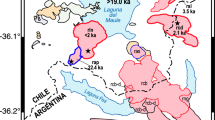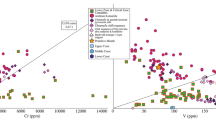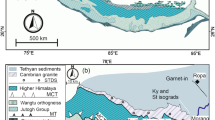Abstract
Garnet-sillimanite-biotite gneiss near Port Leyden, in the western Adirondack Highlands, New York, contains mineral assemblages and textures that formed during high temperature metamorphism and anatexis at mid-crustal pressures. Evidence for melting includes thin, plagioclase-rich veins, sieve textures in biotite, and the presence of small, euhedral garnet neoblasts. Hercynite-silicate equilibria in combination with the solidus for biotite dehydration melting indicate metamorphic pressure was between 4 and 6.4 kbar at the temperature of melting (ca. 735° C). The gneiss is intruded by a small, discordant Fe-Ti oxide-apatite (nelsonite) dike. Reported field occurrences of nelsonite demonstrate its common association with anorthosite plutons. Although no anorthosite bodies are exposed in the Port Leyden region, the presence of nelsonite is evidence of anorthositic magmatism in the western Adirondacks. Post-intrusion metamorphism has caused partial apatite recrystallization and produced a weak foliated texture in the dike. U-Pb ages from zircon and monazite from both the gneiss and the nelsonite dike indicate that these rocks experienced a complex, polymetamorphic history that we interpret to reflect two thermal episodes. An older event is recorded by discordant zircons in the gneiss, which indicate a minimum age of 1129±6 Ma. A linear best fit to the data yields an upper intercept at 1166±53 Ma. This range of ages coincides with anorthosite-suite magmatism in the Adirondacks. A minimum zircon age of 1104±3 Ma was obtained from the nelsonite dike. Lead-loss or late zircon crystallization at about 1020 Ma affected the U-Pb systematics of zircon in the dike. Monazite ages from both rocks also indicate high temperature metamorphism (>700° C) between 1040 and 960 Ma. The older zircon ages and textural relations in the metapelite are viewed as evidence for anatexis at ca. 1150 Ma, and the presence of nelsonite suggests that the intrusion of anorthosite was coincident with partial melting in the gneiss. P-T estimates of metamorphism, therefore, imply that anorthosite was emplaced to about 15 km depth in the western Adirondack Highlands.
Similar content being viewed by others
Author information
Authors and Affiliations
Additional information
Received: 13 September 1994 / Accepted: 10 May 1995
Rights and permissions
About this article
Cite this article
Florence, F., Darling, R. & Orrell, S. Moderate pressure metamorphism and anatexis due to anorthosite intrusion, western Adirondack Highlands, New York. Contrib Mineral Petrol 121, 424–436 (1995). https://doi.org/10.1007/s004100050107
Issue Date:
DOI: https://doi.org/10.1007/s004100050107




